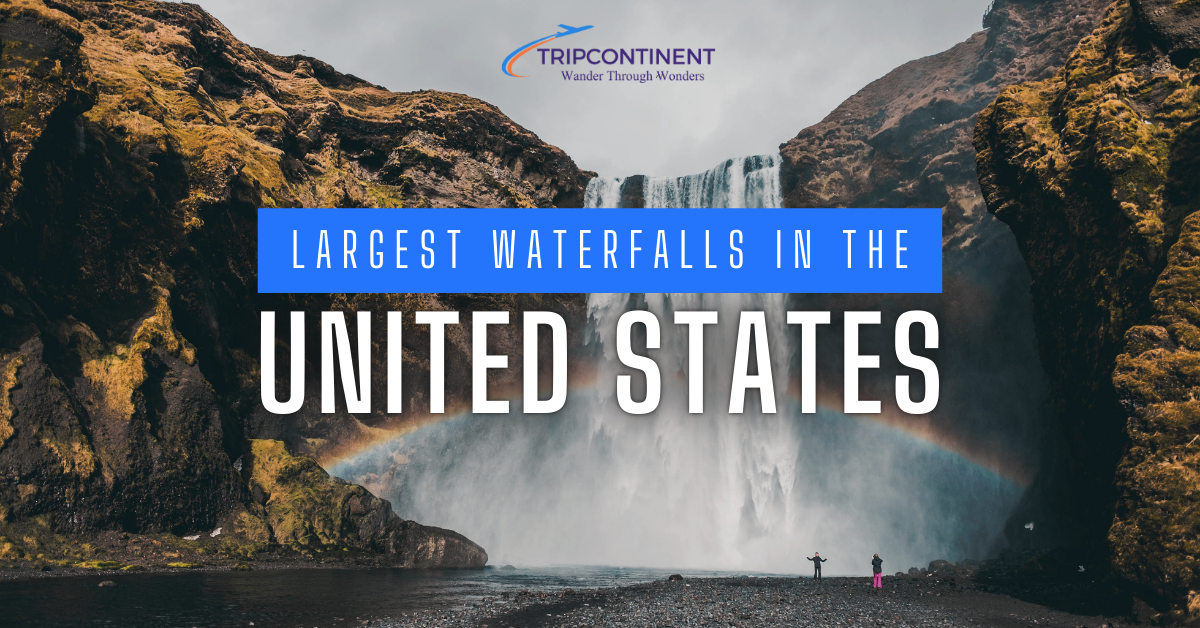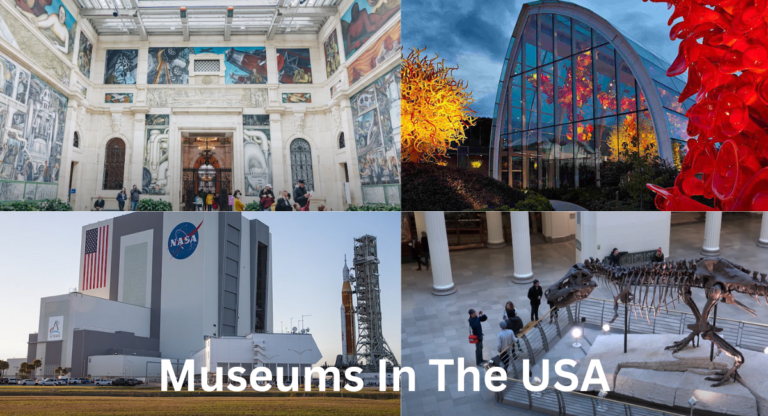A Tour of the Largest Waterfalls in the United States
Waterfalls are created when rivers or streams descend over a cliff or steep slope, creating a dramatic drop that showcases the raw force of nature. The U.S. boasts a diverse range of waterfalls, each with its unique character and charm.
These natural charms can be found in a variety of landscapes, from the lush forests of the Pacific Northwest to the rugged mountains of the Rockies and the serene wilderness of the Appalachian Mountains.
From the thunderous cascades of the iconic Niagara Falls to the serene beauty of hidden gems like Sandstone Falls, the Largest Waterfalls in the United States captivate visitors with their sheer power and breathtaking beauty. Let’s explore them!
List of the Largest Waterfalls in the United States
The following is the list of the largest waterfalls in the United States.
- Niagara Falls
- Kaaterskill Falls
- Screw Auger Falls
- Great Falls of the Passaic
- Big Manitou Falls
- Tahquamenon Falls
- Burgess Falls
- Sandstone Falls
- Lower Falls of the Yellowstone
- Upper Mesa Falls
- Yosemite Falls
1. Niagara Falls
Niagara Falls, straddling the border between the United States and Canada, is one of the most famous and awe-inspiring natural wonders in North America. Comprising three distinct waterfalls—the American Falls, Bridal Veil Falls, and the Horseshoe Falls—Niagara Falls is renowned for its immense size and stunning beauty.
The American Falls and Bridal Veil Falls are located on the U.S. side in New York, while the Horseshoe Falls, the largest of the three, lies primarily on the Canadian side. Together, these falls have the highest flow rate of any waterfall in North America, with over 3,160 tons of water flowing over the falls every second.
Visitors to Niagara Falls can enjoy a variety of experiences. The Maid of the Mist boat tour offers a close-up view of the falls, providing an exhilarating experience as the boat navigates through the misty spray. For those who prefer a different perspective, the Cave of the Wind allows visitors to walk along wooden platforms right at the base of Bridal Veil Falls, feeling the power of the rushing water.
In addition to its natural beauty, Niagara Falls has significant historical and cultural importance. It has been a popular destination for honeymooners, adventurers, and tourists from around the world for centuries. The falls also play a crucial role in hydroelectric power generation, harnessing the immense energy of the water to provide electricity to the surrounding region.
Also read: Largest Railway Networks in the World
2. Kaaterskill Falls
Kaaterskill Falls, located in the heart of New York’s Catskill Mountains, is one of the tallest and most picturesque waterfalls in the United States. This stunning two-tiered waterfall has a combined drop of 260 feet, making it a must-visit destination for nature lovers and adventure seekers alike.
The upper tier of Kaaterskill Falls plunges 175 feet, while the lower tier cascades another 85 feet into a pool. Surrounded by lush forests and rugged cliffs, the falls offer a serene escape from the hustle and bustle of everyday life. The area is especially beautiful in the fall when the vibrant foliage adds a splash of color to the already breathtaking scenery.
Hiking to Kaaterskill Falls is a popular activity, with a moderately challenging trail leading visitors to several vantage points. The trail to the base of the falls offers an up-close view of the cascading water, while the more adventurous can continue to the top for a bird’s-eye perspective. Along the way, hikers are treated to the sights and sounds of the pristine forest, with opportunities to spot local wildlife and enjoy the tranquility of the natural surroundings.
Kaaterskill Falls has a rich history and has inspired countless artists, writers, and photographers. Its beauty was famously captured by the Hudson River School painters in the 19th century, and it continues to be a source of inspiration today.
3. Screw Auger Falls
Screw Auger Falls, located in Maine’s Grafton Notch State Park, is a captivating natural wonder that enchants visitors with its unique rock formations and serene surroundings. This beautiful waterfall cascades through a series of pools and drops, totaling about 30 feet in height, making it a charming yet accessible destination for nature enthusiasts and casual visitors alike.
The falls get their name from the distinctive way the water carves through the bedrock, creating smooth, swirling patterns reminiscent of a screw auger. The water flows through a narrow gorge, plunging into a crystal-clear pool at the base, offering a refreshing spot for wading and enjoying the cool mountain water on a hot summer day.
A short, easy hike from the parking area leads to Screw Auger Falls, making it an ideal stop for families and those looking for a quick yet rewarding adventure.
Screw Auger Falls is not only a scenic spot but also a geological marvel. The falls and the surrounding area offer insight into the region’s geological history, with the exposed rock formations telling a story of ancient volcanic activity and glacial erosion.
4. Great Falls of the Passaic
The Great Falls of the Passaic, located in Paterson, New Jersey, is one of the largest and most impressive waterfalls in the United States. With a height of 77 feet and a width spanning 280 feet, this powerful waterfall showcases the raw beauty and force of nature.
The Great Falls is not just a natural wonder but also a site of historical significance. In 1791, Alexander Hamilton, one of the Founding Fathers of the United States, recognized the fall’s potential for industrial development. He founded the city of Paterson and established it as the nation’s first planned industrial city, using the falls to power mills and factories. This marked the beginning of America’s industrial revolution, with the Great Falls playing a pivotal role in the country’s economic growth.
Visitors to the Great Falls can explore the surrounding Paterson Great Falls National Historical Park, which offers various walking trails, viewing platforms, and informative exhibits.
The Great Falls also holds cultural significance, having inspired poets, artists, and photographers for centuries.
You might also like: Most Traded Currencies in the World
5. Big Manitou Falls
Big Manitou Falls, located in Pattison State Park near Superior, Wisconsin, is a breathtaking natural wonder and the tallest waterfall in the state. This impressive cascade plunges 165 feet over a rugged escarpment, making it a stunning sight and a popular destination for nature enthusiasts and visitors.
The falls are part of the Black River, which has carved its way through the rocky landscape, creating a dramatic drop that showcases the raw power of nature. The surrounding area features lush forests, scenic trails, and picturesque viewpoints, providing ample opportunities for hiking, photography, and wildlife observation.
Pattison State Park offers several vantage points to view Big Manitou Falls, including an observation deck that provides a panoramic view of the waterfall and its surrounding landscape. The park’s trails are relatively easy to navigate, making it accessible for families and casual hikers. During the fall and spring, the falls are particularly impressive as the water flow is more substantial.
Native American legends and local folklore often highlight the falls as a place of great beauty and spiritual importance.
6. Tahquamenon Falls
Tahquamenon Falls, located in Tahquamenon Falls State Park in Michigan’s Upper Peninsula, is one of the largest and most impressive waterfalls east of the Mississippi River. The falls are divided into two main sections: the Upper Falls and the Lower Falls.
This stunning cascade features a drop of 48 feet and spans 200 feet across. It’s the more powerful of the two sections, with a remarkable flow rate that can be particularly striking in spring and early summer when the water levels are highest.
Located about four miles downstream from the Upper Falls, the Lower Falls consist of a series of five smaller cascades that create a picturesque and serene setting.
Tahquamenon Falls State Park offers various recreational opportunities, including hiking, fishing, and camping. The park’s trails provide access to both the Upper and Lower Falls, allowing visitors to explore the diverse landscape and enjoy the tranquility of the wilderness.
7. Burgess Falls
Burgess Falls, located in Burgess Falls State Park in central Tennessee, is a striking series of waterfalls on the Falling Water River. The park features four waterfalls, each more impressive than the last, culminating in the majestic Burgess Falls with a drop of 136 feet into a deep gorge.
Visitors to Burgess Falls State Park can enjoy a variety of outdoor activities, including hiking, fishing, and birdwatching. The main trail, a moderately challenging 1.5-mile round-trip hike, provides stunning views of the river and its waterfalls.
The park’s viewing platforms offer excellent vantage points for photography and soaking in the natural beauty.
Burgess Falls State Park is also rich in flora and fauna, with diverse plant life and abundant wildlife. The park’s lush surroundings provide a perfect habitat for various bird species, making it a popular spot for birdwatching enthusiasts.
Also explore: Seven Wonders of the World
8. Sandstone Falls
Sandstone Falls, nestled within the New River Gorge National Park and Preserve in West Virginia, is a captivating natural wonder. This stunning waterfall spans 1,500 feet across the New River and features a series of cascades with drops ranging from 10 to 25 feet, creating a picturesque and dynamic landscape.
Visitors can access Sandstone Falls via the Sandstone Falls Boardwalk, a well-maintained trail that provides an easy and accessible route to the falls. The boardwalk meanders through the lush forest and over rocky terrain, offering several vantage points to admire the falls and the surrounding scenery.
The falls are divided by a series of islands, which can be explored via footbridges that connect the different sections.
Sandstone Falls is also a popular spot for fishing, picnicking, and photography. The calm pools at the base of the falls are ideal for fishing, while the surrounding picnic areas provide a perfect setting for a relaxing day outdoors.
9. Lower Falls of the Yellowstone
The Lower Falls of the Yellowstone River is one of the most iconic and breathtaking waterfalls in Yellowstone National Park, Wyoming. Plunging 308 feet, nearly twice the height of Niagara Falls, the Lower Falls is the tallest waterfall in the park and offers a spectacular display of nature’s power and beauty.
Located in the Grand Canyon of Yellowstone, the Lower Falls is surrounded by striking geological features and vibrant colors. The canyon’s walls are composed of rhyolite rock, which, combined with the effects of hydrothermal activity, creates a palette of red, yellow, and orange hues that contrast beautifully with the river’s blue-green waters.
Visitors can experience the grandeur of the Lower Falls from several vantage points. The most popular viewpoint is Artist Point, which offers a stunning panoramic view of the falls and the canyon. Another excellent spot is the Brink of the Lower Falls Trail, a short but steep hike that takes visitors to the top of the falls for an up-close look at the thundering water as it plunges into the canyon below. From a different perspective, the Red Rock Point and Lookout Point trails provide breathtaking views from various angles.
The ever-changing mist and rainbows often visible near the base of the falls add to the mesmerizing scene, making it a favorite spot for capturing stunning images.
The Lower Falls hold significant geological and ecological importance. It also plays a crucial role in the river’s ecosystem, supporting a diverse range of plant and animal life.
Yellowstone National Park, home to the Lower Falls, offers a wealth of recreational opportunities, including hiking, wildlife viewing, and exploring geothermal features.
10. Upper Mesa Falls
Upper Mesa Falls, located in the Caribou-Targhee National Forest in southeastern Idaho, is one of the region’s most stunning natural attractions. This breathtaking waterfall plunges 114 feet over a basalt cliff, creating a spectacular display of nature’s power and beauty. The falls span 200 feet across, offering a wide, dramatic cascade that captivates visitors.
Accessible via the Mesa Falls Scenic Byway, Upper Mesa Falls provides an ideal destination for nature enthusiasts and travelers seeking a scenic retreat. The byway offers a picturesque drive through lush forests and along the banks of the Henry’s Fork of the Snake River, culminating in views of the impressive falls.
The falls are surrounded by rich biodiversity, with dense forests of lodgepole pine, fir, and spruce. The area is also home to a variety of wildlife, including deer, elk, and numerous bird species. Interpretive signs along the trail provide information about the local flora, fauna, and geology, enhancing the educational experience.
11. Yosemite Falls
Yosemite Falls, located in California’s iconic Yosemite National Park, is one of the tallest and most famous waterfalls in North America. With a total drop of 2,425 feet, it is a breathtaking natural wonder that captivates visitors from around the world. Yosemite Falls is divided into three sections: the Upper Falls, the Middle Cascades, and the Lower Falls.
Plunging 1,430 feet, the Upper Falls is the tallest section and one of the most dramatic sights in the park. The water cascades over the granite cliff, creating a thunderous roar and a misty spray that can be felt from viewpoints below.
Middle Cascades consists of a series of five smaller drops totaling 675 feet. Though not as visible from the valley floor, the Middle Cascades contribute to the overall grandeur of Yosemite Falls.
With a drop of 320 feet, the Lower Falls completes the spectacular descent. Easily accessible via a short, paved trail, it provides an up-close view of the final plunge and is a favorite spot for visitors to experience the power and beauty of the falls.
Several vantage points offer stunning views of Yosemite Falls. The Yosemite Valley Loop Trail provides an easy walk to the base of Lower Yosemite Falls, while the strenuous Yosemite Falls Trail offers a challenging hike to the top of the Upper Falls. Along the trail, hikers are rewarded with breathtaking views of the valley, Half Dome, and the Sierra Nevada mountains.
The indigenous Ahwahneechee people have long regarded the falls as a sacred site, and their legends and stories add to the area’s heritage.
Also see: Richest Countries in the World
Conclusion
The largest waterfalls in the United States are not just natural wonders; they are gateways to experiencing the raw beauty and power of nature. Exploring these magnificent falls provides more than just visuals. It’s an opportunity to connect with the diverse landscapes that define America’s natural heritage.
So, whether you’re an adventure seeker or a casual explorer, the largest waterfalls in the U.S. offer a captivating journey into the heart of nature’s grandeur.
FAQs
Where Are the Largest Waterfalls in the United States?
The largest waterfall in the United States by height is Yosemite Falls, located in Yosemite National Park, California. Yosemite Falls has a total drop of 2,425 feet, making it the tallest waterfall in the country.
If you’re considering the largest waterfall by volume, Niagara Falls is the largest in the United States. It straddles the border between the United States and Canada and is known for its massive flow rate and immense width.
What Are the Largest Waterfalls in the World?
The top three largest waterfalls in the world, based on their total height, are:
- Angel Falls (Venezuela) – The tallest waterfall in the world, Angel Falls has an incredible height of 3,212 feet (979 meters) with an uninterrupted drop of 2,648 feet (807 meters).
- Tugela Falls (South Africa) – The second-highest waterfall, Tugela Falls has a total height of 3,110 feet (948 meters). It consists of a series of cascades located in the Drakensberg Mountains.
- Utigord Falls (Norway) – Utigord Falls, also known as Vinnufossen, is the third-highest waterfall, with a height of 2,815 feet (858 meters). It is located in the Sunnmøre region of Norway.
What Is the Largest Waterfall in Asia?
The largest waterfall in Asia is Huangguoshu Waterfall, located in Guizhou, China. Standing 67 meters high and spanning 83 meters wide, Huangguoshu Waterfall is renowned for its impressive size and dramatic appearance. Often referred to as the “Yellow Fruit Tree Waterfall,” it is a major attraction in the region, offering stunning views and a powerful cascade that draws visitors from around the world.
Which Is the Largest Water Lake in Asia?
The largest lake in Asia by surface area is the Caspian Sea. Although it is often referred to as a sea due to its size and salt content, it is technically a lake. The Caspian Sea covers an area of approximately 371,000 square kilometers (143,000 square miles), making it the largest enclosed inland body of water in the world. It is bordered by several countries, including Russia, Kazakhstan, Turkmenistan, Iran, and Azerbaijan.
What Is the Deepest Water in Asia?
The deepest body of water in Asia is Lake Baikal in Siberia, Russia. Lake Baikal is the deepest and oldest freshwater lake in the world, with a maximum depth of approximately 1,642 meters (5,387 feet). It is also notable for its volume, containing about 20% of the world’s unfrozen surface freshwater. The lake is renowned for its unique biodiversity and is a UNESCO World Heritage site.

I’m Sophia Jones, an adventurer at heart from New York City, USA. I live for travel and exploration, always eager to discover new places, meet fascinating people, and try out diverse cuisines. Over the past few years, I’ve traveled to numerous countries, immersing myself in different cultures and creating unforgettable memories.






